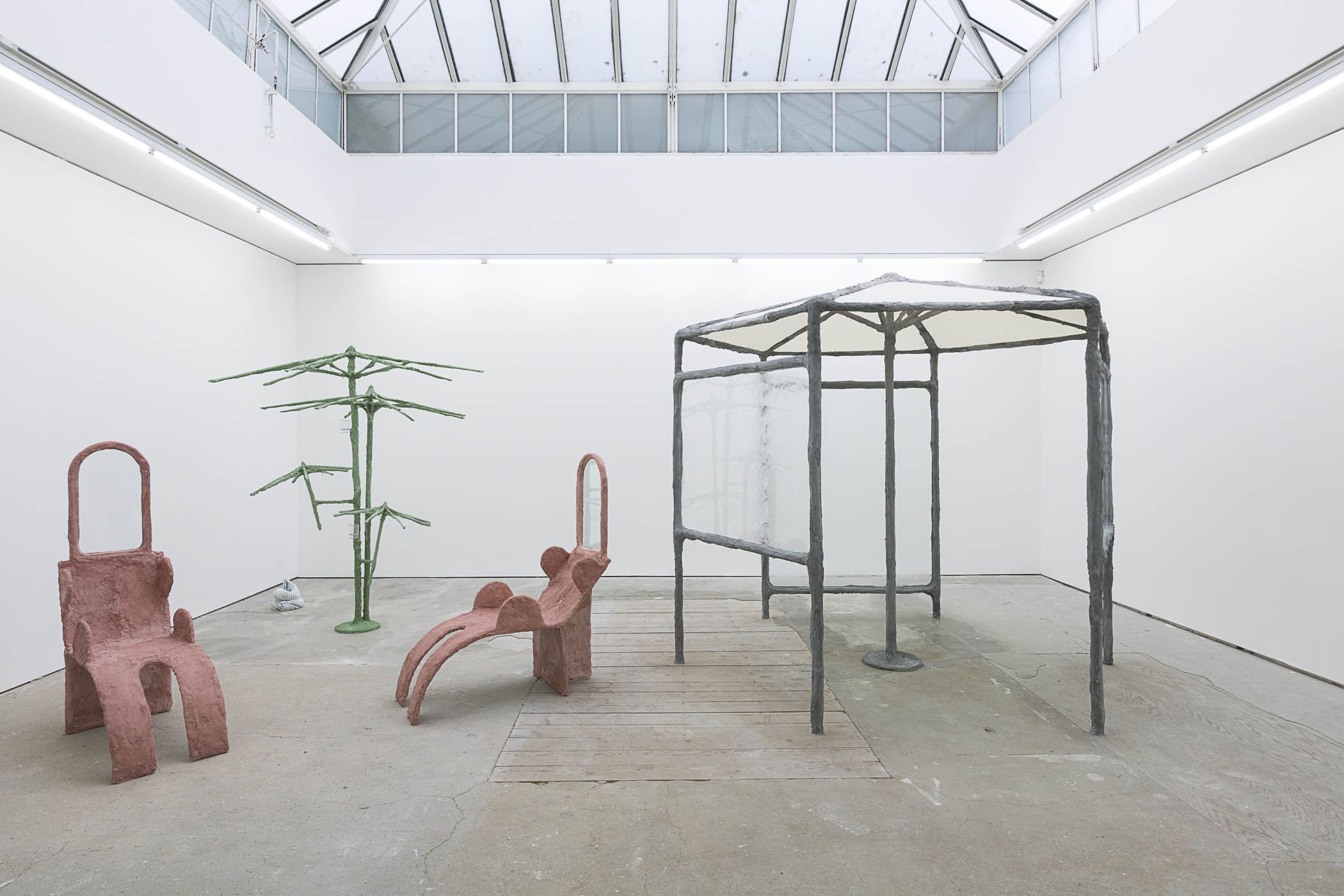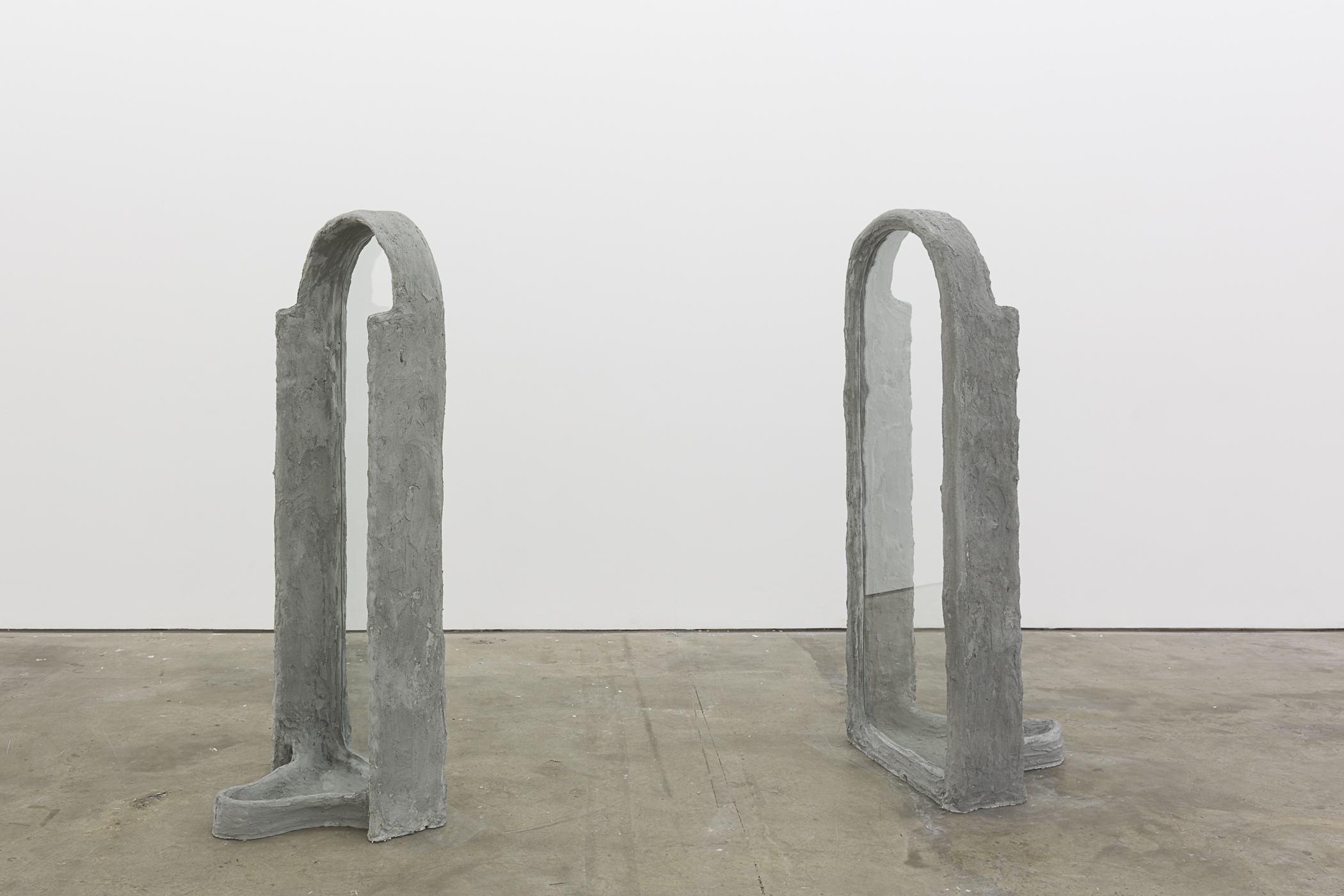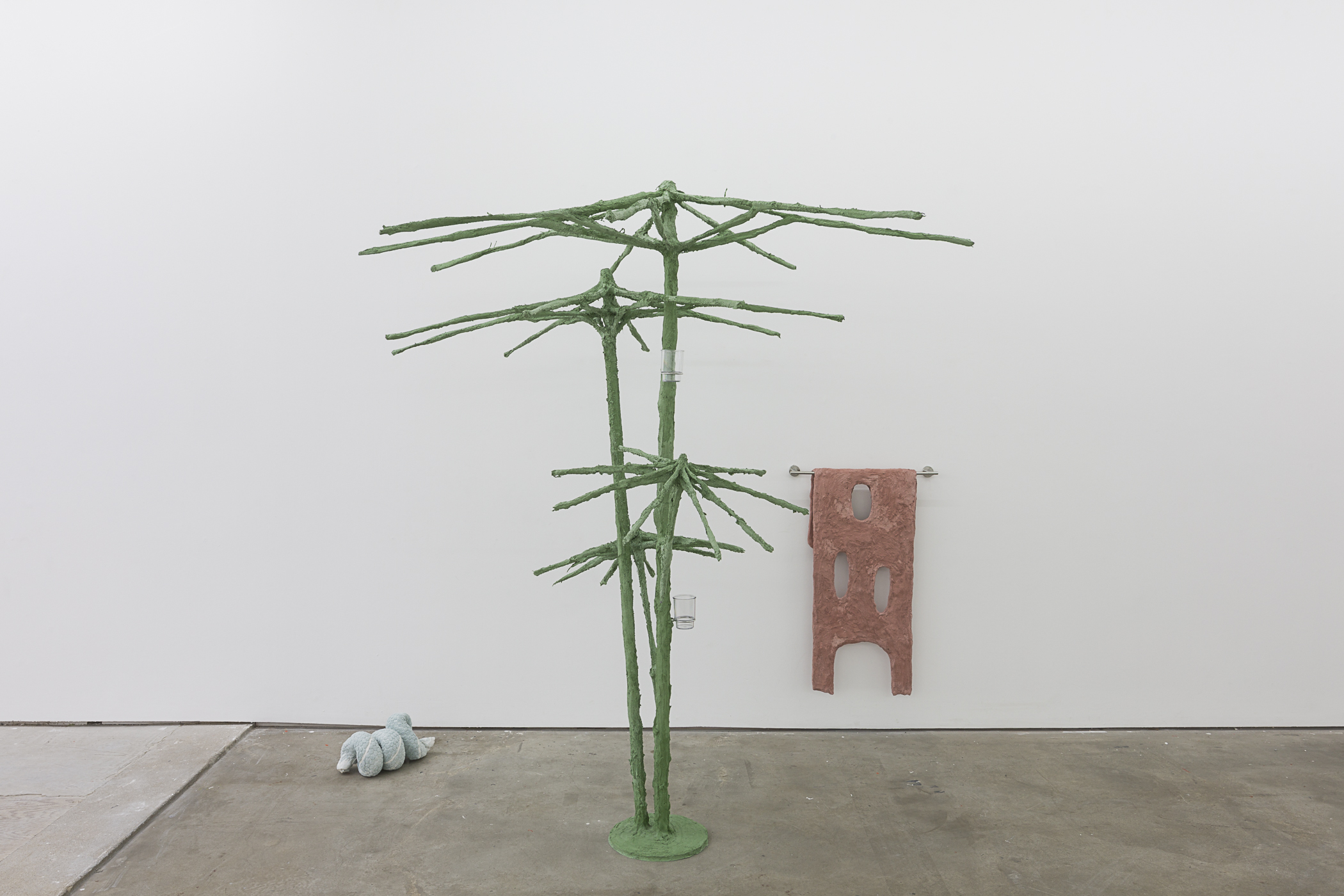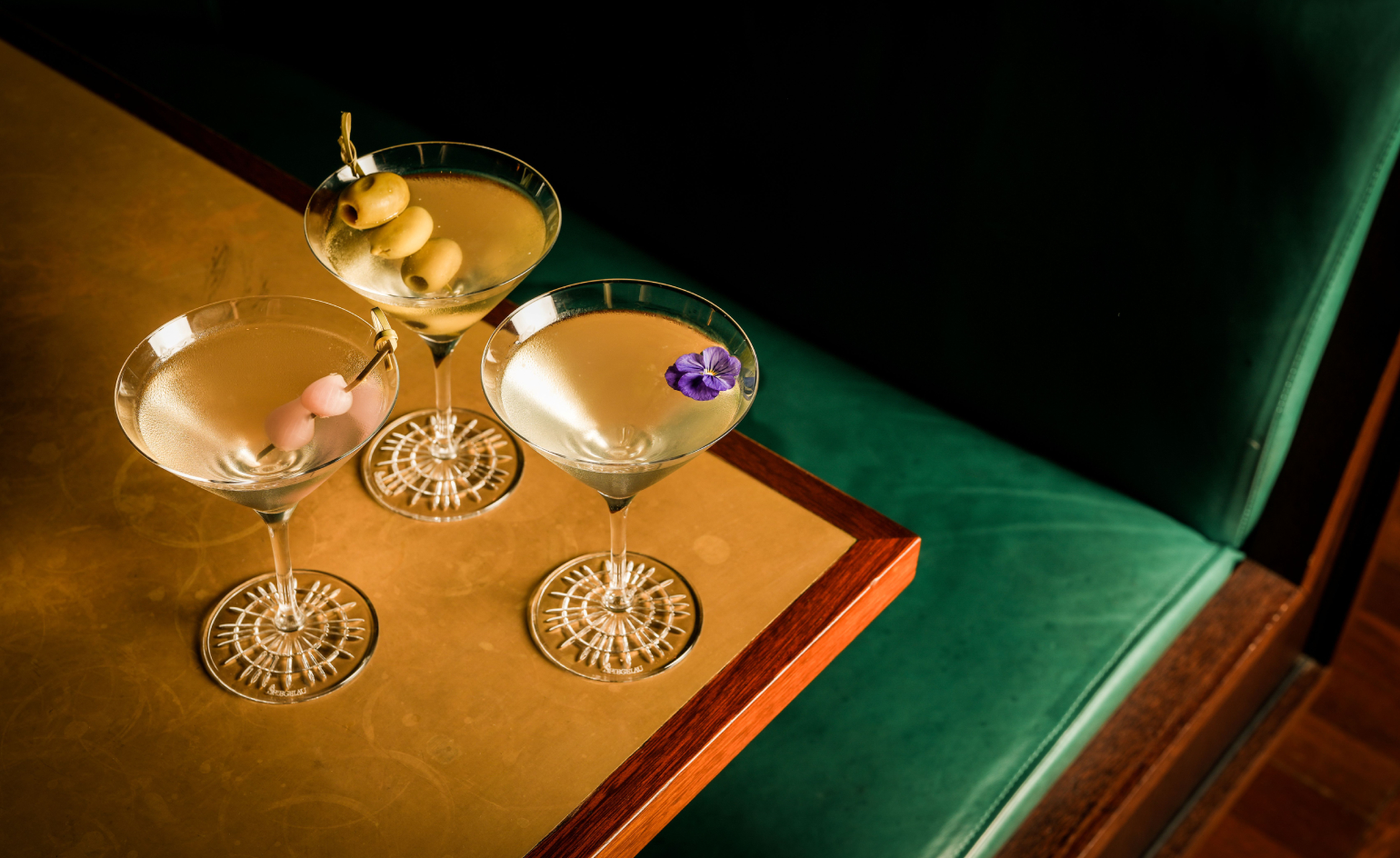Oren Pinhassi presents ‘non-binary’ sculptures at London’s Edel Assanti gallery

The Israeli artist Oren Pinhassi has created sculptures around the world. Whenever he has an exhibition abroad, he doesn’t ship pieces from his studio in East Harlem. Instead, he goes to the country of the exhibition and spends a chunk of time toiling away in the new environment, forming and moulding each and every piece anew. It’s his way of grounding his pieces in their geographical context and exploring the ways in the local environment shapes the way he works.
For his latest show, at Edel Assanti gallery in London’s Fitzrovia, he spent a month in Suffolk creating objects that appear to be familiar archetypes – a palm tree, a chair, or a towel, for example. However, a moment’s concentration transforms them into something completely different. One realises that the palm tree is actually made from steel umbrellas of varying sizes, stacked in a blooming formation; the chair resembles a reclining woman with protruding, misshapen breasts; the towel is grotesquely coiled like a snake. It is this ambiguity and perpetual sense of becoming that Pinhassi exploits, as suggested by the exhibition’s title, ‘Second Nature’.
There’s a palpable erotic energy, with a pair of glass-fronted urinals facing each other, and the palm tree pieces suggestively titled ‘One in the mouth and one in the heart’. A pair of freestanding pavilions, meanwhile are partially lined with glass panels that have been meticulously smeared with swirls of Vaseline, walking a fine line between privacy and voyeurism. Pinhassi embraces the sexual element of his work, though he insists that its ‘queerness’ comes not from these connotations alone. Rather, he stands for a rejection of traditional boundaries: in architecture, in nature, and in the body.
‘I seek to break down binary categories,’ he declares. Interestingly, much of his earlier work featured ‘a lot of wood, and right angles’ – and it was a frustration with the rigidity of the material that drove him to explore the shapeshifting potential of plaster, sand and burlap, which feature prominently in this exhibition.
While there are readymade elements in Pinhassi’s work – the skeletal structures of children’s umbrellas, for instance are used to form the palm trees – there is also ample evidence of the human hand on their primordially rugged surfaces. He calls his sculpting process one of ‘repetitive touch’ – working away at the plaster with his hands a little at a time – no two objects he creates are ever exactly the same. It is this dance between familiarity and ambiguity that informs Pinhassi’s artisanal approach.
Within the ground-level space of the gallery, Pinhassi’s sculptures are carefully placed to guide viewers through a ‘forest’ of nebulous forms. Ultimately, it’s the visitor’s reaction that interests him most, and what this says about the relationship between one’s physical environment and one’s behaviour. ‘I want to see how people instinctually use this space to execute my choreography.’

Urinal (London 1) and Urinal (London 2), glass, steel, plaster, burlap, sand and pigment. Photography: Studio Will Amlot. Courtesy of Edel Assanti

Flanked by two smaller sculptures that nod to towelling, ‘One in the hand and one in the heart’ has a steel frame comprising the skeletal structures of readymade umbrellas, overlaid with plaster, sand and burlap. Photography: Studio Will Amlot. Courtesy of Edel Assanti
INFORMATION
‘Oren Pinhassi: Second Nature’ is on view until 15 August. For more information, visit the Edel Assanti website
ADDRESS
Edel Assanti
74A Newman Street
London W1T 3DB
Receive our daily digest of inspiration, escapism and design stories from around the world direct to your inbox.
-
 The beauty trends that will define 2026, from ultra-niche fragrances to anti-ageing dental care
The beauty trends that will define 2026, from ultra-niche fragrances to anti-ageing dental careAs we enter the new year, we speak to experts in fragrance, skincare, aesthetics, wellness and more about the trends that will be shaping the way we look
-
 The most stylish hotel debuts of 2025
The most stylish hotel debuts of 2025A Wallpaper* edit of this year’s defining hotel openings. Design-led stays to shape your next escape
-
 Neo-Gothic grandeur and decadent martinis await at Hawksmoor St Pancras
Neo-Gothic grandeur and decadent martinis await at Hawksmoor St PancrasThe dining room at the St Pancras London hotel has proved to be a revolving door for big-name chefs; now, it's Hawksmoor’s time to shine
-
 Out of office: The Wallpaper* editors’ picks of the week
Out of office: The Wallpaper* editors’ picks of the week'Tis the season for eating and drinking, and the Wallpaper* team embraced it wholeheartedly this week. Elsewhere: the best spot in Milan for clothing repairs and outdoor swimming in December
-
 Out of office: The Wallpaper* editors’ picks of the week
Out of office: The Wallpaper* editors’ picks of the weekFar from slowing down for the festive season, the Wallpaper* team is in full swing, hopping from events to openings this week. Sometimes work can feel like play – and we also had time for some festive cocktails and cinematic releases
-
 The Barbican is undergoing a huge revamp. Here’s what we know
The Barbican is undergoing a huge revamp. Here’s what we knowThe Barbican Centre is set to close in June 2028 for a year as part of a huge restoration plan to future-proof the brutalist Grade II-listed site
-
 Out of office: The Wallpaper* editors’ picks of the week
Out of office: The Wallpaper* editors’ picks of the weekIt’s wet, windy and wintry and, this week, the Wallpaper* team craved moments of escape. We found it in memories of the Mediterranean, flavours of Mexico, and immersions in the worlds of music and art
-
 Each mundane object tells a story at Pace’s tribute to the everyday
Each mundane object tells a story at Pace’s tribute to the everydayIn a group exhibition, ‘Monument to the Unimportant’, artists give the seemingly insignificant – from discarded clothes to weeds in cracks – a longer look
-
 Out of office: The Wallpaper* editors’ picks of the week
Out of office: The Wallpaper* editors’ picks of the weekThis week, the Wallpaper* team had its finger on the pulse of architecture, interiors and fashion – while also scooping the latest on the Radiohead reunion and London’s buzziest pizza
-
 Out of office: The Wallpaper* editors’ picks of the week
Out of office: The Wallpaper* editors’ picks of the weekIt’s been a week of escapism: daydreams of Ghana sparked by lively local projects, glimpses of Tokyo on nostalgic film rolls, and a charming foray into the heart of Christmas as the festive season kicks off in earnest
-
 Wes Anderson at the Design Museum celebrates an obsessive attention to detail
Wes Anderson at the Design Museum celebrates an obsessive attention to detail‘Wes Anderson: The Archives’ pays tribute to the American film director’s career – expect props and puppets aplenty in this comprehensive London retrospective